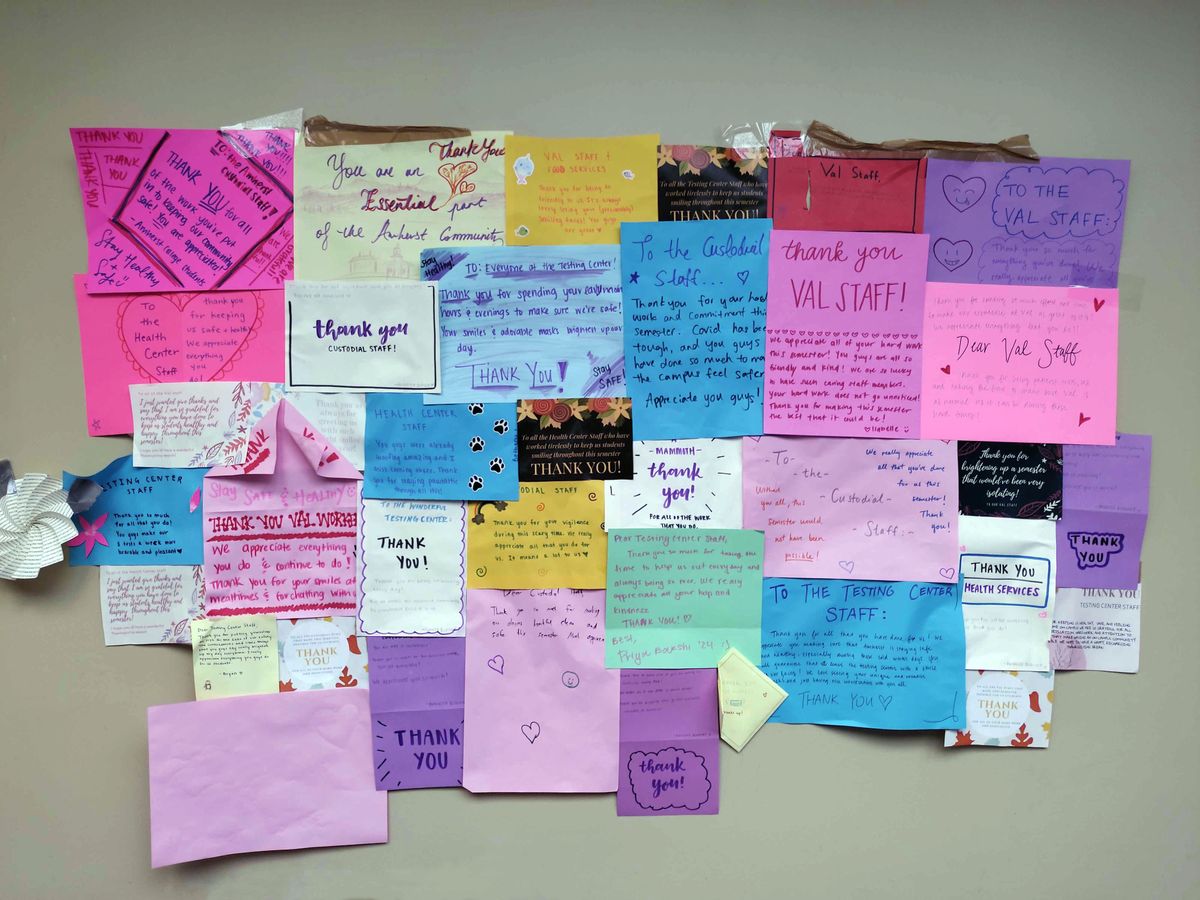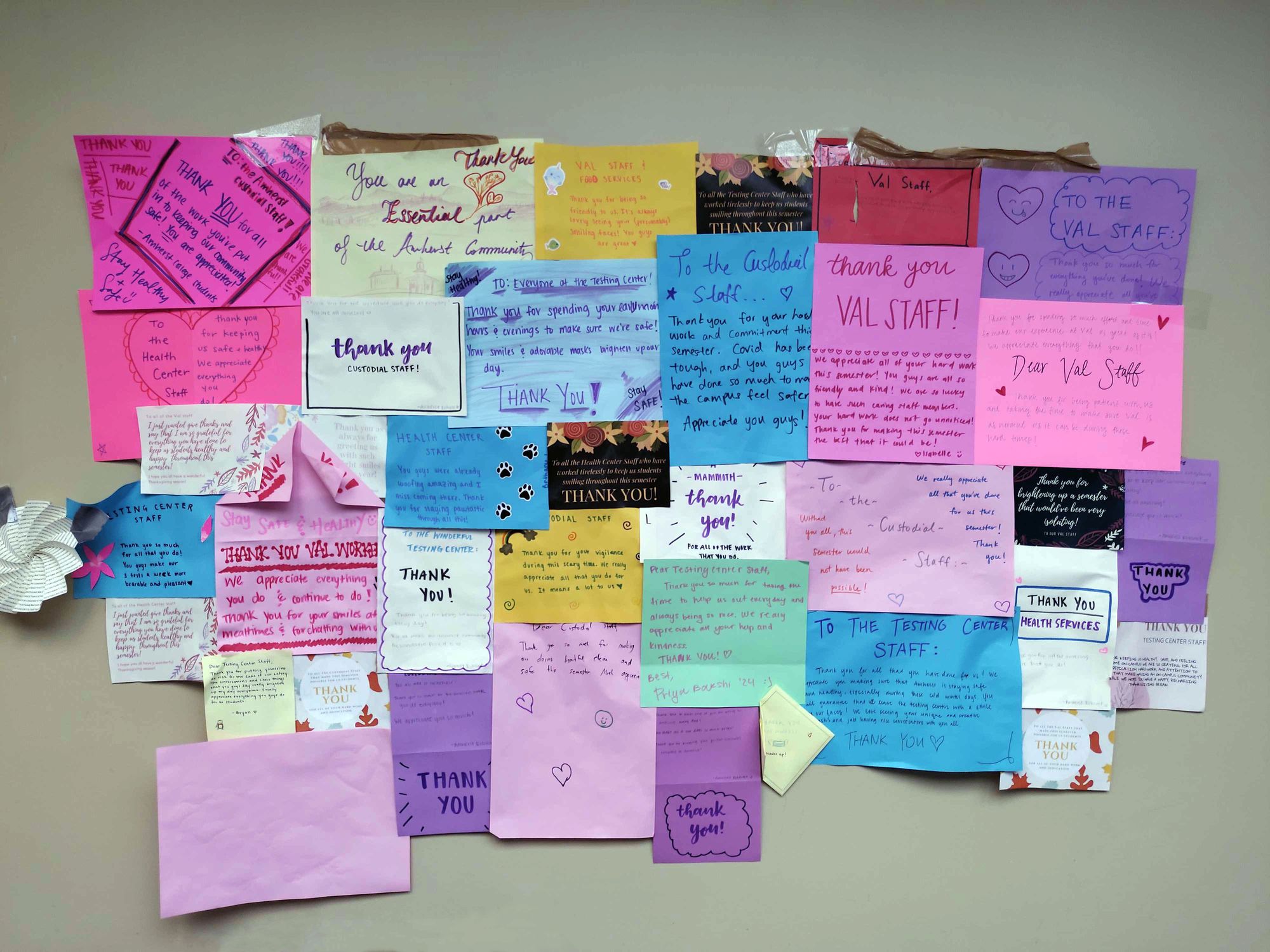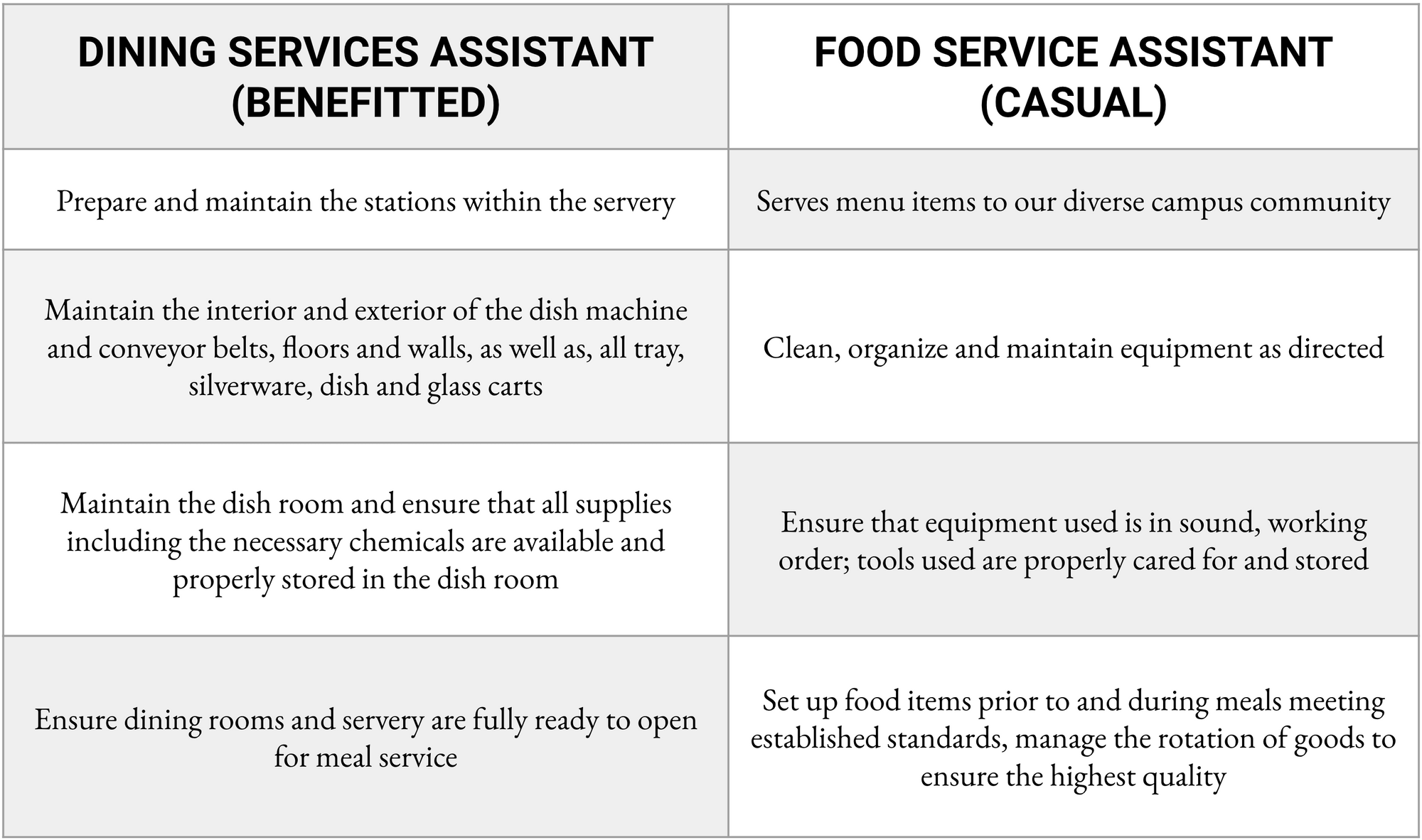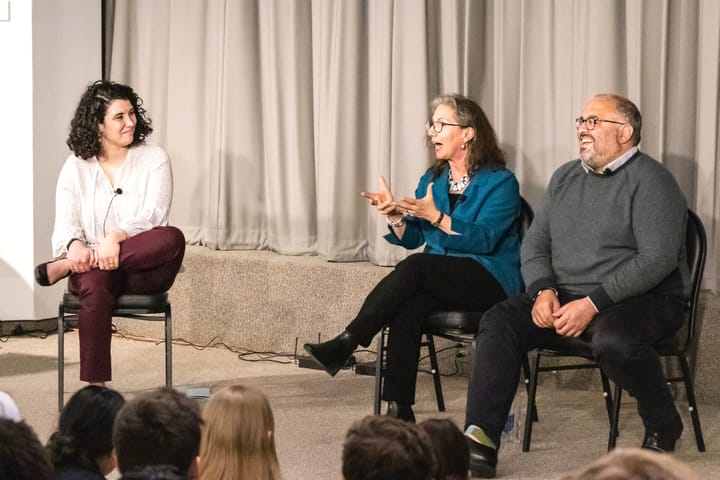Employees Speak Up on College's Casual Employment System
This week, the Student looks into the system of “casual employment” at Amherst College using interviews with nine anonymous facilities staff members and publicly available information. Employee testimony reveals class struggle that underlies the college employment system.

Walk into Valentine Dining Hall on a crowded night for dinner, and some see panini presses, waffle makers and green containers waiting to box up their next meal. Others see an elaborate system of moving parts, where one misstep could set off a ricochet of related setbacks. Food prep staff are in the lower kitchen, preparing food to feed over a thousand. Checkers are at the dining hall entrance, overseeing students as they scan them into the dining hall. Food servers are transferring food onto thousands of plates every single night. Within this system — not to mention the custodial and grounds work departments — there are hundreds of required roles and several different types of employment classifications.
This system, and the human experiences it shapes, deserve a closer look. This week, The Student looks into the system of “casual employment” at Amherst College, using interviews with nine anonymous facilities staff members and publicly available information.
Given the depth and breadth of this situation, The Student acknowledges that these nine interviews will certainly not be representative of the experiences of all casual employees. Still, many of the employees testified that individual stories need to be told because they provide insight into the class struggle that underlies and defines our institution, as well as society as a whole.
Defining Casual Employment, Discrepancies
The Amherst College employee handbook establishes casual employees as employees who “Typically … hold their positions as substitutes for employees on extended leave, to assist in completion of a special project or when there are delays in filling vacancies. Casual employees are usually employed for less than 20 hours per week.” Because of this, the handbook goes on to explain, “casual employees are not covered under the guidelines of the Handbook and are not entitled to employee benefits.” Because this category can apply to any employee and not just student workers, being a casual employee and working less than 20 hours a week are not one and the same. The handbook also notes that “Employees working less than 20 hours a week or less than 39 weeks a year, OR who hold casual positions, are not eligible for benefits.”
Some of the employees interviewed by The Student stated that this system works well for their individual needs. “Not everyone can be a benefitted employee. Not everybody wants that,” said one anonymous casual employee, hereinafter referred to as Employee A. “Right now, I don’t. Throughout my entire time with Amherst College, I’ve needed to ask for crazy amounts of time off during weird, inopportune times.” Others, many of whom are currently working the same 40 hours a week as full-time, benefitted employees, expressed frustration at the discrepancy that leaves them without health insurance and other key benefits. “I started working 40 hours a week my second month here,” said an anonymous casual employee, Employee B, who has now been working at the college for three years. “I’m still getting paid less, and I’m not getting benefits.”
Referencing the weekly dining hall employee schedule, anonymous employees calculated that in the past week, front-of-the-house staff at Val (that is, not including the kitchen and food prep staff) scheduled approximately 1,100 hours of employee labor. Of those 1,100 hours, approximately 50 percent were filled by benefitted employees and 50 percent by casual employees. These sources indicate that these numbers may vary week to week but sustain an approximate 1:1 ratio of labor hours filled by casual employees versus full time employees.
Those 550 hours of casual employee labor were filled by 17 casual employees, meaning that the casual employees working front-of-the-house at Val this past week worked almost 32 hours per person, on average. The range within this average calculation of hours is large, anonymous employee sources stated, as some casual employees work the assumed 20 hours per week, and some work close to or over 40 in some instances.
The college’s system of employment does not allow for casual employees to be converted into benefited employees, so “you can’t just say ‘I’m willing to work 40 hours a week’ and get benefits,” explained an anonymous casual employee, Employee F. “You have to wait for a current full-time employee to leave.” Full-time positions don’t open up very often, employees reported, and when they do, it leaves all casual employees — in addition to any other person interested in applying for the job — to compete for the position. Regardless of the number of casual employees who do not fall under the Employee Handbook’s description of casual employees being those who work less than 20 hours a week and only for brief periods of time, the only time a switch from casual to benefitted can occur is when a position opens and an employee is hired to it. Employee B recounted a coworker who had worked at the college for several years who would “sometimes work up to 45 hours a week, and took as many hours as he possibly could, and he still would stay a ‘casual.’”
Because casual employees are not eligible for employment benefits or “covered under the guidelines of the Employee Handbook,” they do not receive a health care plan, a dental plan, retirement plan, vacation time, paid holidays off or other benefits such as the Educational Assistance plan — which assists in paying tuition for employee education — and Grant-in-Aid program — which assists in paying tuition for employees’ family members.
Another discrepancy between casual employees and benefitted employees is overtime pay. Casual employees start getting paid overtime if they work over 40 hours in one week — overtime pay starts at their 41st hour that week — while benefitted employees get paid overtime if they work over eight hours in one day — starting with the ninth hour worked in their day. Employee A told of a repeated instance where he worked alongside a full-time benefitted employee who was making overtime and therefore making twice as much as he was, for doing almost the exact same tasks. “I knew one person who was so frustrated by the inequity of this — someone who was a part time employee with benefits, working next to a casual,” said Employee A. “He was so frustrated by the inequality that he was making more than her, that he quit.”
In addition, casual employees do not receive the merit and longevity-based raises that full-time, benefitted employees receive on an annual basis. Casual employees are not subject to performance review of any kind, and do not receive automatic annual raises, meaning that the only way they can obtain a raise is by negotiating with management.
The Bigger Picture: Class Struggle
Many employees acknowledged the complexity this situation creates, one even stating that the topic of casual employment at Amherst College could be an entire thesis project.
Two employees drew comparisons between their experiences working at Amherst College and other colleges in the area, and acknowledged that their experience at Amherst College has been far better. “I was at UMass for three years [as an O3, UMass’ term for casual employee], and I didn’t want to go back. Based off of how I was treated here, I am happier here. It is still rough, but it’s a lot better for me,” said one employee, Employee C.
“There are aspects of working at this institution that are amazing,” Employee A similarly stated. “There are these problems, right? But there are also so many amazing things.” Other employees shared similar sentiments and appreciations of the overall workplace environment. “In general, I believe that the college does a far greater job in treating its employees than most workplaces,” stated one employee.
Regarding wages, “In comparison to everything else, the payment here … it’s fair. But that’s within the constraints of society,” reflected Employee A. “On the wider scale, [the college] has made it appear as though they are being fair and reasonable. That is a valid perspective … but it doesn’t mean that it doesn’t breed resentment on other levels.”
In addition, many employees attested to the fact that casual employment differs greatly between sectors of employment at the college. “I am talking from a very upstairs perspective. The situation downstairs is way different,” said another anonymous employee. “The kitchen and the floor have totally different cultures. Way, way different. The casuals that are in the kitchen are taken advantage of in unique ways.”
Thinking about ways that the administration can better address their plights, some employees agreed that sweeping policy change would not be helpful. “Casual employees are not a singular entity with a singular plight,” said Employee A. “Individual casual narratives need to be heard, and their specific needs met in lieu of just some sweeping policy revision.”
Individual stories matter, employees said, because they are evidence of the working class struggle that is never uniform, but fundamental to understanding the culture that Amherst College students help create.
“The institution’s reliance on casual labor is the most apparent example of an inequitable and unjust division of labor. It’s easily recognizable and relatively easily rectified and yet it still exists,” reflected another anonymous employee. “A campus that prides itself on its diversity, equity and inclusivity, does seem to have a problem adopting these ideals in earnest in regards to its own staff. This shouldn't come as a surprise though. Amherst is a beautiful place filled with beautiful ideas and beautifully diverse peoples. It’s also a business. It’s cut and dry and it functions as a business,” they said.
“I feel like it took a pandemic for everyone to start seeing that casuals matter as well,” said another anonymous casual employee, Employee D. “I feel it never should have taken a pandemic to make people realize that us casuals play an important role as well, just as much as the full-time workers.” For Employee D, part of this role is helping uphold the staff’s integral part of the college community, as parents and administrators “depend on us employees to make sure that you [students] are well taken care of … I do try to look out for you,” they said. Employee D recounted a moment during first-year orientation where a group of three first years approached them and asked, “Do you guys get to eat this food as well?” “I told them yes,” said Employee D. “I appreciated them asking. I wish [people] knew that we are … important. We do matter as well.”
Others had similar thoughts about how their work is valued. “Amherst College believes that anyone can do these jobs, and that is reflected in the casual pay rate, which until the pandemic was the state mandated minimum. The raise to $15/hour is a reaction to the labor shortage and larger cultural shift, not a fundamental change in how this institution views the value of casual labor,” said Employee A. “They believe that anyone can scoop food. That anyone can sit at the checker stand. That anyone can wash dishes. That anyone can run green containers back and forth, in and out, because it’s ‘unskilled labor.’ It’s unskilled manual labor.” But the idea that such a thing as “unskilled manual labor” even exists, continued Employee A, has begun to unravel in light of the pandemic, as some have begun to see that “this is hard work. Soft skills and tolerance are actually skills. These are actually skilled positions that most people are unwilling to do because they do not have the skills or the tolerance to hack it. I think that’s super important to change the conversation around food service employees.”
The notion that “anyone can scoop food,” said Employee A, may be right on one level. But “Would you do it? Could you actually do it? Could you do it?” they said. “I think that the people who are making these decisions, that is the question that they should ask themselves. Would you put yourself in this position? They might say, ‘If I had to.’ That’s just the class struggle. That’s quite simply class struggle in a nugget. We have to do this to survive, and you don’t.”
Employee E had similar thoughts. “The class struggle within the Amherst College community is not unlike any other place in the world. But it’s less pronounced for full-time, benefitted employees than it is for many full-time employees with different employers. The most egregious form of this struggle is with casual employees on campus and that's why it’s essential that the college rectifies this wrong,” they said.
“I grew up in a working class family with a parent who lost their job on more than one occasion due to efforts trying to unionize their workplace,” they continued. “I grew up acutely aware of the vast injustices of those that have and those that don't. Stories of class divisions and labor battles were part of my upbringing. I believe in the value and importance of the human being, not just their output.”

The Casual Employees Left Behind
Interviews with several current and former casual employees revealed a few central ways in which the system of casual employment leaves a large chunk of employees in an odd-in between that they believe is unjust. Casual employees who work more than twenty hours a week — and often close to the forty hours a week that full-time benefitted employees work — are oftentimes assigned the same tasks as benefitted employees, despite not receiving equal pay or benefits.
“The fact that the college is still defining casual employment as someone who works around 20 hours a week is really dicey. That does sometimes apply, but it also really doesn’t in so many circumstances,” said Employee A. Employee B, the anonymous casual employee who has been working 40 hours a week for three years now and still remains a casual employee, said: “I just think it’s unfair, really. I’m working almost twice as hard as some of the people here … and I’m still getting paid less and I’m not getting benefits.”
So many casual employees working close to full-time hours get stuck in this situation because the college’s system of employment does not allow for casual employees to be converted into benefitted employees. “You can’t just say ‘I’m willing to work 40 hours a week’ and get benefits,” explained an anonymous casual employee, Employee F. “You have to wait for a current full-time employee to leave.” Full-time positions don’t open up very often, employees reported, and when they do, it leaves all casual employees — in addition to any other person interested in applying for the job — to compete for the position. Regardless of the number of casual employees who do not fall under the Employee Handbook’s description of casual employees being those who work less than 20 hours a week and only for brief periods of time, the only time a switch from casual to benefitted can occur is when a position opens and an employee is hired to it. Employee B recounted a coworker who had worked at the college for several years who would “sometimes work up to 45 hours a week, and took as many hours as he possibly could, and he still would stay a ‘casual.’”
Casual employees report being assigned similar or identical responsibilities as their full-time, benefitted counterparts, which they say adds to the irony of their situation.
For example, the chart below compares and contrasts some of the listed job responsibilities on the job advertisements for “Dining Services Assistant,” a full-time, benefitted position in dining services, and “Casual Food Service Assistant,” the casual equivalent of dining services assistant, according to dining hall employees.

There are some differences in the job expectations for casual and benefitted employees, including benefitted employees’ responsibility to “oversee” casual employees. Casual employees are also expected to fill in and cover for other employees. “Your employment is contingent upon that flexibility,” said Employee A. Employee E, a casual employee, brought up this issue in his own schedule. “I wish the college would be more considerate of employees,” he said. “There are employees that have kids, there are employees that still take care of family, or employees that don’t have cars and take transportation such as buses … it would be a lot easier for us if [the administration] could work around that.” One potential change Employee A brought up is coordinating employee schedules with the PVTA schedule, which so many employees rely on for transportation but is not synced with clock-in time.
Moving Forward
As to the question of what the college should do to address this issue, employees had thoughts. “I would want to see that if [employees] are working forty hours a week or are willing to work forty hours, make it easier to become full time with benefits. Don’t have a limit on how many benefitted spots there are, so that if you have more people who are willing to work forty hours but they want benefits, give them the benefits and then they’ll work,” said Employee F. “Amherst is a 2 billion dollar institution — but where is that money, actually?”
Similarly, asked another anonymous employee, “What’s the overall value of an equitable workforce to this institution? Are the hundreds of thousands of dollars that are saved through limiting full-time benefitted roles on campus worth it, knowing that there is an inequitable division of labor on campus? That’s the question.”





Comments ()